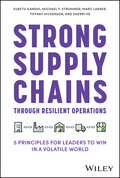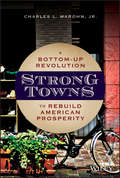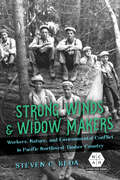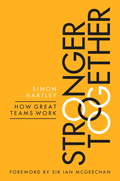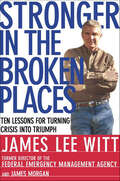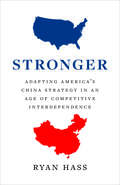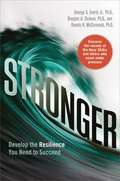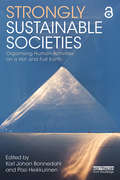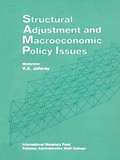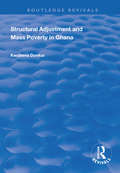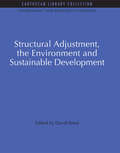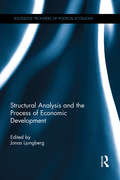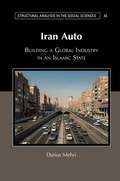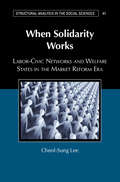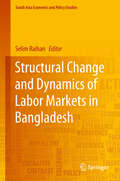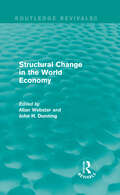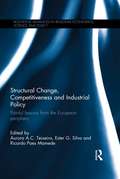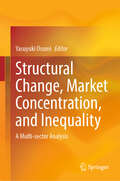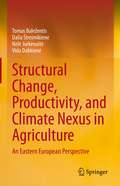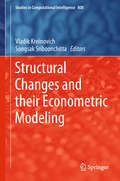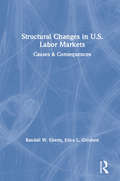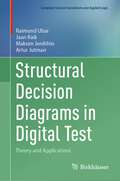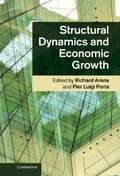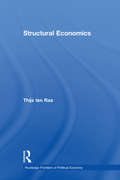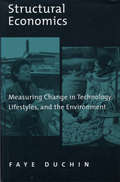- Table View
- List View
Strong Supply Chains Through Resilient Operations: Five Principles for Leaders to Win in a Volatile World
by Michael F. Strohmer Suketu Gandhi Marc Lakner Tiffany Hickerson Sherri HeFuture-proof your firm’s supply chains with a renewed focus on resilience In Strong Supply Chains Through Resilient Operations: Five Principles for Leaders to Win in a Volatile World, a team of dedicated, veteran operations strategists delivers a practical and hands-on discussion of how to future-proof your company’s supply chains through a relentless focus on resilience. In the book, you’ll discover how to shift your firm’s emphasis from “low-cost” to “low volatility” as you protect your company against the supply and demand shocks associated pandemics, wars, labor disputes, and trade conflicts. You’ll also learn about: Real-world examples of companies realizing long-term competitive advantage by implementing the shifts advocated by the authors Why seeking to build mutually beneficial, long-term relationships with dependable suppliers is preferable to always choosing the cheapest option How a renewed focus on diversity and new ways of working can create resilient operations teams that pass on value to your customers An effective and essential discussion of one of the most prominent challenges facing contemporary companies around the world, Strong Supply Chains Through Resilient Operations is a need-to-read book for managers, executives, business leaders, entrepreneurs, operations and supply chain professionals, and anyone else with a stake in the smooth operation of their firm.
Strong Towns: A Bottom-Up Revolution to Rebuild American Prosperity
by Charles MarohnA new way forward for sustainable quality of life in cities of all sizes Strong Towns: A Bottom-Up Revolution to Build American Prosperity is a book of forward-thinking ideas that breaks with modern wisdom to present a new vision of urban development in the United States. Presenting the foundational ideas of the Strong Towns movement he co-founded, Charles Marohn explains why cities of all sizes continue to struggle to meet their basic needs, and reveals the new paradigm that can solve this longstanding problem. Inside, you’ll learn why inducing growth and development has been the conventional response to urban financial struggles—and why it just doesn’t work. New development and high-risk investing don’t generate enough wealth to support itself, and cities continue to struggle. Read this book to find out how cities large and small can focus on bottom-up investments to minimize risk and maximize their ability to strengthen the community financially and improve citizens’ quality of life. Develop in-depth knowledge of the underlying logic behind the “traditional” search for never-ending urban growth Learn practical solutions for ameliorating financial struggles through low-risk investment and a grassroots focus Gain insights and tools that can stop the vicious cycle of budget shortfalls and unexpected downturns Become a part of the Strong Towns revolution by shifting the focus away from top-down growth toward rebuilding American prosperity Strong Towns acknowledges that there is a problem with the American approach to growth and shows community leaders a new way forward. The Strong Towns response is a revolution in how we assemble the places we live.
Strong Winds and Widow Makers: Workers, Nature, and Environmental Conflict in Pacific Northwest Timber Country (Working Class in American History)
by Steven C. BedaOften cast as villains in the Northwest's environmental battles, timber workers in fact have a connection to the forest that goes far beyond jobs and economic issues. Steven C. Beda explores the complex true story of how and why timber-working communities have concerned themselves with the health and future of the woods surrounding them. Life experiences like hunting, fishing, foraging, and hiking imbued timber country with meanings and values that nurtured a deep sense of place in workers, their families, and their communities. This sense of place in turn shaped ideas about protection that sometimes clashed with the views of environmentalists--or the desires of employers. Beda's sympathetic, in-depth look at the human beings whose lives are embedded in the woods helps us understand that timber communities fought not just to protect their livelihood, but because they saw the forest as a vital part of themselves.
Stronger Together: How Great Teams Work
by Simon HartleyWhat do world-class teams do that others don't? How do those teams think, make decisions and respond to challenges?Stronger Together will help readers to understand what differentiates world-class teams from the rest. Using these insights, readers can apply the same key principles when leading - or being a part of - a team, whether they are in a business or sports environment. To illustrate how world-class teams operate and how they're led, the author draws on examples of teamwork from a diverse range of disciplines, from The Red Arrows to SAS Units, a Formula One Pit Crew, Americas Cup yacht crews, World Championship sports teams and more. He includes case studies from his work with elite professional, international and Olympic sports teams, plus executive leadership teams from businesses.This truly insightful and fascinating book lifts the lid on what it takes to be the best and how we can translate these lessons to our own performance.
Stronger in the Broken Places: Ten Lessons for Turning Crisis into Triumph
by James Morgan James Lee WittFrom the former director of the Federal Emergency Management Agency, how to manage your business in the face of challenge, change, and potential disasterFor James Lee Witt, the man who rebuilt America's emergency response system, the most inspiring and effective lessons--about responsibility, team building, planning, and taking action--have guided real-life heroes through extraordinary situations. These lessons can be applied to business to guide you through the pressures you face each week--or once in a career or a lifetime. Whether describing earthquake preparation in California, moving a Missouri town out of a floodplain, or shoring up walls and spirits after the Oklahoma City bombing, Witt captures the moments when leaders step forward, how they motivate others, and what they need to triumph over adversity. Witt's home-spun wisdom teaches us to "Tear Down the Stovepipes" to build effective teamwork by thinking horizontally, not vertically; to find energizing people who improve morale, whether a V.P.'s secretary or a key client, since "A Lightning Rod Works Both Ways"; and to establish systems for capturing what happens--what goes right and what goes wrong--to ensure that every challenge leaves you "Stronger in the Broken Places." To bring home the ten lessons in this inspiring and useful book, Witt shares examples and strategies from corporations--from Malden Mills and Intel to Swissair and Kmart--who have overcome crisis by applying the same principles to their business every day.
Stronger: Adapting America’s China Strategy in an Age of Competitive Interdependence
by Ryan HassAn examination of the U.S.–China relationship that charts a new path for America focusing on its existing advantages Ryan Hass charts a path forward in America&’s relationship and rivalry with China rooted in the relative advantages America already possesses. Hass argues that while competition will remain the defining trait of the relationship, both countries will continue to be impacted—for good or ill—by their capacity to coordinate on common challenges that neither can solve on its own, such as pandemic disease, global economic recession, climate change, and nuclear nonproliferation. Hass makes the case that the United States will have greater success in outpacing China economically and outshining it in questions of governance if it focuses more on improving its own condition at home than on trying to impede Chinese initiatives. He argues that the task at hand is not to stand in China&’s way and turn a rising power into an enemy in the process but to renew America&’s advantages in its competition with China.
Stronger: Develop the Resilience You Need to Succeed
by George S. Everly Jr. Dennis K. Mccormack Douglas A. StrouseProfessional athletes, surgeons, first responders--all perform remarkable feats in the face of intense stress. Why do they thrive under pressure, while others succumb?What separates the two is attitude. Resilient people meet adversity head-on and bounce back from setbacks. They seem to naturally exude an inner strength--but studies show that resilience is something that anyone can build. Analyzing the heroic exploits of U.S. Navy SEALs and others who succeed against all odds, Stronger identifies five factors that combine to unlock deep reserves of personal power:Active optimism--believe that you can change things for the betterDecisive action--you can't succeed if you don't take the leapMoral compass--face any challenge with clear guiding principlesRelentless tenacity--try, try againInterpersonal support--gain strength from those around youDrawing on the unique perspective of a standout team of authors (a stress management expert, a skilled entrepreneur, and a Navy SEAL), Stronger explores the science behind resilience and explains how you can develop this vital trait for yourself. Whatever your profession, today's demanding world calls for a special kind of strength. This revealing book holds the key.
Strongly Sustainable Societies: Organising Human Activities on a Hot and Full Earth (Routledge Studies in Sustainability)
by Karl Johan Bonnedahl Pasi HeikkurinenThe response of the international community to the pressing socio-ecological problems has been framed around the concept of ‘sustainable development’. The ecological pressure, however, has continued to rise and mainstream sustainability discourse has proven to be problematic. It contains an instrumental view of the world, a strong focus on technological solutions, and the premise that natural and human-made ‘capitals’ are substitutable. This trajectory, which is referred to as ‘weak sustainability’, reproduces inequalities, denies intrinsic values in nature, and jeopardises the wellbeing of humans as well as other beings. Based on the assumptions of strong sustainability, this edited book presents practical and theoretical alternatives to today’s unsustainable societies. It investigates and advances pathways for humanity that are ecologically realistic, ethically inclusive, and receptive to the task’s magnitude and urgency. The book challenges the traditional anthropocentric ethos and ontology, economic growth-dogma, and programmes of ecological modernisation. It discusses options with examples on different levels of analysis, from the individual to the global, addressing the economic system, key sectors of society, alternative lifestyles, and experiences of local communities. Examining key topics including human–nature relations and wealth and justice, this book will be of great interest to students and scholars of environmental and development studies, ecological economics, environmental governance and policy, sustainable business, and sustainability science.
Structural Adjustment and Macroeconomic Policy Issues
by V. A. JafareyA report from the International Monetary Fund.
Structural Adjustment and Mass Poverty in Ghana (Routledge Revivals)
by Kwabena DonkorFirst published in 1997, this volume looks at the rationale for, the implementation of, and the economic and social effect of the World Bank Structural Adjustment Policy (SAP) in Ghana from the early 1980s to the early 1990s. It shifts the focus from a primarily economic evaluation of these programmes and includes issues such as their impact on vulnerable groups within the Ghanaian society and on poverty in general. Therefore, it must be asked whether the ‘ordinary Ghanaian’ has gained anything from any wealth creation in Ghana. The book will be useful for both academic and policy purposes.
Structural Adjustment, the Environment and Sustainable Development: Structural Adjustment, The Environment And Sustainable Development (Environmental and Resource Economics Set)
by David ReedThis is a pioneering study which should serve as a model for future research and will to a wide audience' Dharam Ghai, Director United Nations Research Institute for Social Development Structural Adjustment and the Environment (Earthscan, 1992) was the first book to fully examine the effects of 'structural adjustment programmes the economic reform policies required by the World Bank and IMF as part of their lending operations with borrowing countries. To widespread Critical acclaim it exposed the damaging environmental and social effects of structural adjustment policies, and called for a thorough revision of the then-current development policy. This new work; Structural Adjustment, the Environment and sustainable Development is a major step forward in the study of structural adjustment policies. It looks in detail at new research and analysis into their effects, and incorporates recent studies by a wide range of academics and policy-makers, leading experts and institutes. Focusing on nine in-depth case studies, the book examines the complex links between macroeconomic policies, social impacts and environmental outcomes, and takes a forward-looking perspective in outlining the alternatives to current structural adjustment policies. Review quotes for Structural Adjustment and the Environment 'Should be essential reading for all students of development' Third World Planning Review 'Breaks new ground in the debate on structural adjustment generally. and in the environment/development debate' International Affairs 'The most substantial contribution to date to what is undoubtedly an important area' Development and Change David Reed is director of the Macroeconomics for Sustainable Development Programme of WWF International, and editor of Structural Adjustment and the Environment (Earthscan, 1992). Originally published in 1996
Structural Analysis and the Process of Economic Development (Routledge Frontiers of Political Economy)
by Jonas LjungbergEconomic development is full of discontinuities. Mainstream economists perceive these as external disturbances to a natural state of equilibrium, but this book argues that much of the discontinuities are part of economic development, suggesting that patterns can be understood with structural analysis. Structural Analysis and the Process of Economic Development presents a detailed analysis of the trajectory of Swedish economic change since the nineteenth century. The emergence of structural analysis in economic research is reviewed, as well as a chapter devoted to development blocks, a key concept that was outlined in the 1940s and that has much in common with the more recent notions ‘techno-economic paradigms’ and ‘general-purpose technologies’. Structural analysis and the major contributions by Schön are introduced in this book. Also highlighted is Sweden’s integration into the international economy via the nineteenth century capital markets, along with structural analysis as a tool for understanding climate change. The recent technique of wavelet analysis and its potential for structural analysis is demonstrated in a non-technical chapter. This book is suitable for those who are interested in and study political economy, economic history and European history.
Structural Analysis in the Social Sciences: Building a Global Industry in an Islamic State (Structural Analysis in the Social Sciences #43)
by Darius MehriSince the revolution of 1979, scholars have portrayed the Islamic State's industrial development capacity in a negative light. Global isolation, incoherent economic planning, and predatory Islamic institutions are often cited as the reasons for lackluster development. In Iran Auto: Building a Global Industry in an Islamic State, Darius Mehri shows how this characterization is misguided. Today, Iran has one of the world's largest automobile industries with national technical capacity. Previous studies ignore the consequences of three decades of Iran's capacity for successful industrialization and changes in global technology transfer that allow countries, even ones isolated from formal global institutions, to build an automobile industry. Mehri shows how industrial nationalists in Iran constructed a network of politically effective relationships to open up space for successful local industrial development, and then tapped into a set of important global linkages to create an industry with high local manufacturing content. This book will open up a new line of inquiry into how countries in the global south can develop a successful national automobile industry without the need to conform to global economic institutions.
Structural Analysis in the Social Sciences: When Solidarity Works
by Lee Cheol-SungWhy do some labor movements successfully defend the welfare state even under the pressures of neo-liberal market reform? Why do some unions (and their allied parties and civic associations) succeed in building more universal and comprehensive social policy regimes, while others fail to do so? In this innovative work, Cheol-Sung Lee explores these conundrums through a comparative historical analysis of four countries: Argentina, Brazil, South Korea and Taiwan. He introduces the notion of 'embedded cohesiveness' in order to develop an explanatory model in which labor-civic solidarity and union-political party alliance jointly account for outcomes of welfare state retrenchment as well as welfare state expansion. Lee's exploration of the critical roles of civil society and social movement processes in shaping democratic governance and public policies make this ideal for academic researchers and graduate students in comparative politics, political sociology and network analysis.
Structural Change and Dynamics of Labor Markets in Bangladesh (South Asia Economic and Policy Studies)
by Selim RaihanOutlining important policy requirements for Bangladesh to become an upper middle-income country, the book presents research work conducted during the project “Changing Labor Markets in Bangladesh: Understanding Dynamics in Relation to Economic Growth and Poverty,” sponsored by the International Development Research Center (IDRC), Canada. Bangladesh has experienced remarkable economic growth rates over the last decade. The country has recently been upgraded from a low-income country (LIC) to a lower-middle-income country (LMIC) as per the World Bank’s classification system. By 2024, the country also aspires to graduate from the United Nation’s list of least developed countries (LDC). The 7th five-year plan sets an ambitious target of 8 percent growth in GDP by 2020. There are also steep development targets to be achieved under the Sustainable Development Goals (SDGs) by 2030. All these will require an enormous leap forward from the current level of economic growth rate and sustaining it in the future. The situation also calls for considerable structural change in the economy, facilitating large-scale economic diversification. Rapid expansion of labor-intensive and high-productivity sectors, both in the farm and nonfarm sectors, is thus crucial for Bangladesh. Further, this should take place in conjunction with interventions to enhance productivity, jobs and incomes in traditional and informal activities where there are large pools of surplus labor. Given its relevance for Bangladesh and applicability to many other developing countries, the book offers a unique and pioneering resource for researchers, industry watchers as well as policy makers.
Structural Change in the World Economy (Routledge Revivals)
by John H. Dunning Allan WebsterThe chapters in this edited collection, first published in 1990, examine the key aspects of change in the global economy at the end of the twentieth century and the role of national government policies in this. Drawing on material from a wide range of disciplines, including international trade, technology and economic history, the authors discuss the implications of these changes for the world’s leading capitalist economies. With an analysis of the prospects for the future, this relevant title will be of particular value to students of business studies and economics and those researching the global economy over the past thirty years.
Structural Change, Competitiveness and Industrial Policy: Painful Lessons from the European Periphery (Routledge Advances in Regional Economics, Science and Policy)
by Aurora A.C. Teixeira Ester Silva Ricardo Paes MamedeThe onset of the global crisis has emphasised the persistence of substantial differences in development and social progress within the euro area. The specific case of countries located in the southern periphery region has come to the centre stage, due to the harsh economic conditions that all these countries have experienced in the recent past. In the aftermath of the American subprime credit bubble, these countries’ high indebtedness raised doubts as to their ability to sustain public finances, with the financial crisis developing and gaining momentum due to the fragilities presented in the economy. To varying degrees of severity, all of these economies have since been forced to introduce strong fiscal tightening programmes in order to achieve fiscal consolidation, which have translated into recession and rising unemployment. This book undertakes a comprehensive analysis of the causes of the crisis in southern European countries, showing that the ‘Achilles heel’ of these economies is rooted in the dismal evolution of productivity and in a specialisation pattern excessively based on the so-called ‘traditional’, low, and low-medium tech industries, which yield low margins, declining export shares and, ultimately, withering international competitiveness. Such evidence suggests that the southern European periphery industrial growth model has reached its limits, demanding a multidimensional policy approach capable of overcoming the magnitude and complexity of the present crisis. Without denying the need to adjust public and private balance sheets, it is argued that finding a sustainable path out of the present problems requires addressing the challenges of productivity growth and competitiveness in the long term.
Structural Change, Market Concentration, and Inequality: A Multi-sector Analysis
by Yasuyuki OsumiThis book clarifies the mechanism of widening income inequality and declining labor share in macroeconomics, growth, technology, and the labor market, and provides policy implications. The volume covers three research themes: the influence of structural change, the advancement of artificial intelligence, and the phenomena of market concentration on inequalities and labor share dynamics in theory and empirics. The wide array of theoretical topics in this book includes the implications of unbalanced growth, economy-wide elasticity of substitution between capital and labor, relatively rising service sectors, superstar firm phenomena, automation, the heterogeneity of capital, increasing returns to scale, and the information and financial service sectors on inequalities and labor share decline. These analyses are based on multifactor, multisector general equilibrium, the goods market, and the labor market’s imperfectly competitive framework. In addition, the book covers the relevant empirical data analyses that involve top wealth dynamics in the U.S. Forbes 400, the effect of deepening ICT capital on the labor share in major Japanese industries, and the emergence of increasing returns to scale in the Japanese information and financial sectors.
Structural Change, Productivity, and Climate Nexus in Agriculture: An Eastern European Perspective
by Dalia Štreimikienė Tomas Baležentis Nelė Jurkėnaitė Vida DabkienėThis monograph addresses the methodological and empirical issues relevant for the development of sustainable agriculture, with a particular focus on Eastern Europe. It relates economic growth to the other dimensions of sustainability by applying integrated methods. The book comprises five chapters dedicated to the theoretical approaches towards sustainable rural development, productivity analysis, structural change analysis and environmental footprint. The book focuses on the transformations of the agricultural sector while taking into account economic, environmental, and social dynamics. The importance of agricultural transformations to the livelihood of the rural population and food security are highlighted. Further, advanced methodologies and frameworks are presented to fathom the underlying trends in different facets of agricultural production. The authors present statistical methods used for the analysis of agricultural sustainability along with applications for agriculture in the European Union. Additionally, they discuss the measures of efficiency, methodological approaches and empirical models. Finally, the book applies econometric and optimization techniques, which are useful for the estimation of the production functions and other representations of technology in the case of the European Union member states. Therefore, the book is a must-read for researchers and students of agricultural and production economics, as well as policy-makers and academia in general.
Structural Changes and their Econometric Modeling (Studies in Computational Intelligence #808)
by Vladik Kreinovich Songsak SriboonchittaThis book focuses on structural changes and economic modeling. It presents papers describing how to model structural changes, as well as those introducing improvements to the existing before-structural-changes models, making it easier to later on combine these models with techniques describing structural changes. The book also includes related theoretical developments and practical applications of the resulting techniques to economic problems. Most traditional mathematical models of economic processes describe how the corresponding quantities change with time. However, in addition to such relatively smooth numerical changes, economical phenomena often undergo more drastic structural change. Describing such structural changes is not easy, but it is vital if we want to have a more adequate description of economic phenomena – and thus, more accurate and more reliable predictions and a better understanding on how best to influence the economic situation.
Structural Changes in U.S. Labour Markets: Causes and Consequences
by Randall E. Eberts Erica L. Groshen Lee HoskinsDuring much of the 1980s, US wage growth has been unexpectedly slow in the face of relatively low unemployment rates and high capacity utilization rates. This collection of papers resulting from the Wage Structure Conference held by the Federal Research Bank of Cleveland, November 1989, helps explain labour market behaviour in that period. The contributors - academic and research economists in labour economics - provide a comprehensive assessment of the current state of the wage-setting process in the US labour market.
Structural Decision Diagrams in Digital Test: Theory and Applications (Computer Science Foundations and Applied Logic)
by Jaan Raik Raimund Ubar Maksim Jenihhin Artur JutmanThis is the first book that sums up test-related modeling of digital circuits and systems by a new structural-decision-diagrams model. The model represents structural and functional information jointly and opens a new area of research.The book introduces and discusses applications of two types of structural decision diagrams (DDs): low-level, structurally synthesized binary DDs (SSBDDs) and high-level DDs (HLDDs) that enable diagnostic modeling of complex digital circuits and systems.Topics and features:Provides the definition, properties and techniques for synthesis, compression and optimization of SSBDDs and HLDDsProvides numerous working examples that illustrate the key points of the textDescribes applications of SSBDDs and HLDDs for various electronic design automation (EDA) tasks, such as logic-level fault modeling and simulation, multi-valued simulation, timing-critical path identification, and test generationDiscusses the advantages of the proposed model to traditional binary decision diagrams and other traditional design representationsCombines SSBDDs with HLDDs for multi-level representation of digital systems for enabling hierarchical and cross-level solving of complex test-related tasksThis unique book is aimed at researchers working in the fields of computer science and computer engineering, focusing on test, diagnosis and dependability of digital systems. It can also serve as a reference for graduate- and advanced undergraduate-level computer engineering and electronics courses.Three authors are affiliated with the Dept. of Computer Systems at the Tallinn University of Technology, Estonia: Raimund Ubar is a retired Professor, Jaan Raik and Maksim Jenihhin are tenured Professors. Artur Jutman, PhD, is a researcher at the same university and the CEO of Testonica Lab Ltd., Estonia.
Structural Dynamics and Economic Growth
by Richard Arena Pier Luigi PortaEver since Adam Smith, economists have been preoccupied with the puzzle of economic growth. The standard mainstream models of economic growth were and often still are based either on assumptions of diminishing returns on capital with technological innovation or on endogenous dynamics combined with a corresponding technological and institutional setting. An alternative model of economic growth emerged from the Cambridge School of Keynesian economists in the 1950s and 1960s. This model - developed mainly by Luigi Pasinetti - emphasizes the importance of demand, human learning and the growth dynamics of industrial systems. Finally, in the past decade, new mainstream models have emerged incorporating technology or demand-based structural change and extending the notion of balanced growth. This collection of essays reassesses Pasinetti's theory of structural dynamics in the context of these recent developments, with contributions from economists writing in both the mainstream and the Cambridge Keynesian traditions and including Luigi Pasinetti, William Baumol, Geoffrey Harcourt and Nobel laureate Robert Solow.
Structural Economics (Routledge Frontiers of Political Economy #Vol. 58)
by Thijs ten RaaThis book aims to make the nature of input-output analysis in economics clearly accessible and, contrary to the opinion of many commentators, shows that this type of analysis can be compatible with the doctrines of neoclassical economics.
Structural Economics: Measuring Change in Technology, Lifestyles, and the Environment
by Faye DuchinIn all societies, the main causes of environmental degradation are resource extraction and the generation of waste by households and industries. Realistic strategies for mitigating these impacts require an understanding of both the technologies by which resources are transformed into products, and the lifestyle choices that shape household use of such products.Structural Economics provides a framework for developing and evaluating such strategies. It represents an important new approach to describing household lifestyles and technological choices, the relationships between them, and their impact on resource use and waste. In this volume, economist Faye Duchin provides for the first time an authoritative and comprehensive introduction to the field, including its social and technological dimensions.Duchin's primary achievement is integrating a qualitatively rich understanding of technologies and lifestyles into a flexible, quantitative framework grounded in established principles of input-output economics and social accounting. She uses tools and insights from areas as diverse as demography and market research to conceptualize and describe different categories of households and their lifestyles. She also draws on the expertise of engineers and physical scientists to examine the potential for technological change. The framework Duchin develops permits the rigorous and detailed analysis of specific scenarios for alternative technologies and changes in lifestyle.The new field of structural economics represents an important step forward in the effort to apply the power of science to solving the problems of modern societies. This book should prove invaluable to students and scholars of economics, sociology, or anthropology, as well as environmental scientists, policymakers at all levels, and anyone concerned with a practical interpretation of the elusive concept of sustainable development.
